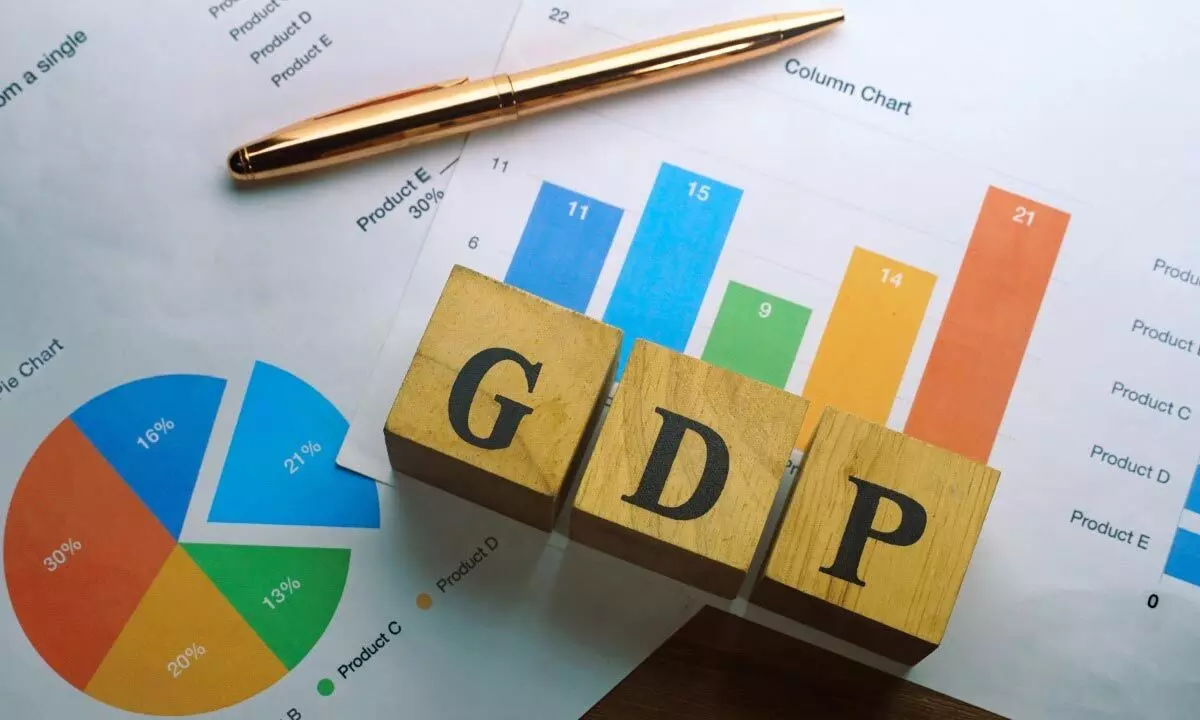India's GDP growth likely to be 8.2-8.5% in FY22
Cumulative rate hike in June & August may be 75 bsp
image for illustrative purpose

Mumbai: India's FY22 GDP growth is projected to be at 8.2-8.5 per cent. Q4 FY22 GDP numbers are due for release on May 31 and it is difficult to comprehend the numbers as a spate of customary quarterly revisions in FY22 on May 31 could make it a forecaster's nightmare.
Nevertheless, analysts believe FY22 GDP numbers could move closer to 8.5 per cent as Q4 GDP numbers as per SBI nowcasting Model. The other big puzzle could be the gap between GVA and GDP numbers in Q4 given the strong growth in tax collections. This could push up the GDP number significantly, even as GVA might be much lower.
SBI's internal economic research team has projected GDP growth for FY22 at 8.5 per cent and Q4 FY22 at 2.7 per cent. The study, however, believes the GDP projection for Q4 FY22 is clouded by significant uncertainties. For example, even a 1 per cent downward revision in Q1 GDP estimates of FY22 from 20.3 per cent, all other things remaining unchanged could push Q4 GDP growth to 3.8 per cent. Here is a break up of numbers. The CSO had projected Q4 GDP at Rs 41.04 lakh crores and FY22 real GDP growth at Rs 147.7 lakh crores, an improvement of 1.7 per cent over pre pandemic levels. SBI Nowcasting model with an unchanged quarterly numbers pegs the growth rate of Q4GDP at Rs 40 lakh crore that is lower by Rs 1 lakh crore from the CSO preliminary projections.
"We believe that downward adjustments in Q1, Q2, Q3 numbers could have a soothing impact on Q4 GDP numbers. Every Rs 10,000 crore revision adds/ subtracts 7 basis points from GDP growth," says Soumya Kanti Ghosh, SBI group' chief economic advisor.
Beyond the numbers, early trend of Q4FY22 results from Corporate, in the listed space, reported better growth numbers across parameters as compared to Q4FY21 albeit contraction in operating margin due to higher input cost. Sectors such as steel, FMCG, chemicals, IT-software, auto ancillary, paper, etc. reported better growth numbers. However, sector such as automobile, cement, capital goods – electrical equipment, edible oil etc, though reported growth in top line in Q4FY22, registered negative growth in PAT, as compared to Q4 FY22.
Meanwhile globally, while the average real GDP y-o-y growth in Q1 2022 for 25 economies at 5.5 per cent is a tad higher that the preceding quarter, GDP growth is marking an abrupt reversal in major economies (US, France, Italy and Sweden). The US economy unexpectedly contracted in the Q1 2022 (on sequential basis) amid a resurgence in Covid-19 cases and drop in pandemic relief money from the government. This is the first decline in GDP since the short and sharp pandemic recession nearly two years ago. Global financial volatility continues amidst the prolonged Russia-Ukraine crisis. However, after touching the level of 3 per cent, that is double its level at the start of the year and the highest since December 2018, US 10-year yield has declined in the recent weeks mainly on account of rising fears of recession. Investors are already wary of rising inflationary pressures, however, certain economic data including new jobless claims rising to a 4-month high and negative leading index have further sparked concerns that pricing pressures are starting to now take a toll on economic growth.
Meanwhile, Brent crude has remained sticky. As per the monthly Oil Market report of OPEC, total world demand of crude for 2022 stands at 100.29 mb/d compared to 96.92 mb/d in 2021. Even the total production is expected to grow 2.53 per cent to 71.23 mb/d from 68.71 mb/d in 2021.
Analysts are sceptical that crude prices may not sustain at this high level for long. RBI is expected to hike rates in the June policy meeting and the cumulative rate hike in June and August is likely to be 75 basis points. A history of monetary and fiscal policy coordination in the Indian context for the 30 year period ended FY2020 reveals statistically insignificant negative correlation between the two, implying least coordinated policies, even as RBI had successfully staved off automatic monetization and even private placement of fresh issues with RBI, with the enactment of FRBM in 2003.
The best thing that has emerged during pandemic is the coordinated policy response by both the Government and RBI in staving off the pandemic and now inflation. In recent times, there has been a lot of debate regarding the coordination of monetary and fiscal policy, as evident in the recently released book by Dr Viral Acharya, former DG of RBI. The friction in coordination between monetary and fiscal authorities has been a thorny issue globally in recent years particularly after the global financial crisis. Against this background the policy response by RBI and Government needs to be wholeheartedly complemented.
The RBI has largely been successful in communicating to the market about its intentions and seems to have managed the art of managing expectations much better. In fact, RBI Governor has politely conveyed the message of steadfast resolve of monetary policy support through crisp one liners, the effectiveness of what was discussed in Jackson Hole meeting in Aug 2020!

